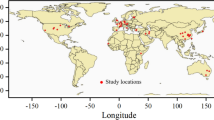Summary
A simple experimental model has been devised to study the effects of organic amendments on aggregate stability and microbial activity in the soil. In the two soils investigated the different organic materials used all produced increases in aggregate stability but significant differences were observed both in the magnitude and time of the increase attributable to individual treatments. Microbial activity, as assessed by visual techniques, was broadly correlated with the changes in aggregate stability though the different treatments tended to produce their own characteristic patterns of colonization. It was generally difficult to relate changes in aggregate stability with the activity of specific micro-organisms but in the case of samples treated with glucose and cellulose, yeasts were the dominant organisms. These have subsequently been shown to produce substantial quantities of an extracellular polysaccharide which is effective in bringing about aggregation.
Similar content being viewed by others
References
Acton, C. J., Rennie, D. A., and Paul, E. A., The relationship of polysaccharides to soil aggregation. Can. J. Soil Sci.43 141–150 (1963).
Bond, R. D., The occurrence of microbial filaments in soils and their effect on some soil properties. C.S.I.R.O. (Adelaide), Divisional report (1960).
Brady, B. L. and Jones, D., British Records:Lipomyces starkeyi Lod. & Rij. Trans. Brit. Mycol. Soc.47 293 (1964).
Chesters, G., Attoe, O. J., and Allen, O. N., Soil aggregation in relation to various soil constituents. Soil Sci. Soc. Am. Proc.21 272–277 (1957).
Clapp, C. E., Davis, R. J., and Waugaman, S. H., The effect of Rhizobial polysaccharides on aggregate stability. Soil. Sci. Soc. Am. Proc.26 446–469 (1962).
Geoghegan, M. J. and Brian, R. C., Aggregate formation in soil: 1. Influence of some bacterial polysaccharides on the binding of soil particles. Biochem, J.43 5–13 (1948).
Greenland, D. J., Lindstrom, G. R., and Quirk, J. P., Role of polysaccharides in stabilization of natural soil aggregates. Nature (London)191 1283–1284 (1961).
Griffiths, E. and Jones, D., Colonization of cellulose by soil micro-organisms. Trans. Brit. Mycol. Soc.46 285–294 (1963).
Haines, W. B., Studies in the physical properties of soil: V. The hysteresis effect in capillary properties, and the modes of moisture distribution associated therewith. J. Agr. Sci.20 97–116 (1930).
Harris, R. F., Allen, O. N., Chesters, G., and Attoe, O. J., Evaluation of micro-bial activity in soil aggregate stabilization and degradation by the use of artificial aggregates. Soil Sci. Soc. Am. Proc.27 542–546 (1963).
Iimura, K. and Egawa, T., A study on decomposition of organic matter and aggregate formation. Soil and Plant Food2 83–88 (1956).
Jones, D. and Griffiths, E., The use of thin soil sections for the study of soil micro-organisms. Plant and Soil20 232–240 (1964).
Low, A. J., The study of soil structure in the field and the laboratory. J. Soil Sci.5 57–74 (1954).
Martin, J. P., Some observations on the synthesis of polysaccharides by soil bacteria. J. Bacteriol.50 349–360 (1945).
Martin, J. P., Micro-organisms and soil aggregation: II. Influence of bacterial polysaccharides on soil structure. Soil Sci.61 157–166 (1946).
Martin, J. P., Martin, W. P., Page, J. B., Raney, W. A., and De Ment, J. D., Soil Aggregation. Advances in Agron.7 1–37 (1955).
Martin, J. P., Ervin, J. O., and Shepherd, R. A., Decomposition and aggregating effect of fugus cell material in soil. Soil Sci. Soc. Amer. Proc.23 217–220 (1959).
McCalla, T. M., Biological agencies in soil aggregation. Influence of biological products on soil structure and infiltration. Soil Sci. Soc. Amer. Proc.7 209–214 (1942).
McCalla, T. M., Water-drop method of determining stability of soil structure. Soil Sci.58 117–121 (1944).
Mishustin, E. N., The labile part of soil macrostructure. Pedology2 122–130 (1945).
Parkinson, D. and Waid, J. S., (Ed.) The Ecology of Soil Fungi. Liverpool, University Press. (1960).
Rennie, D. A., Truog, E., and Allen, O. N., Soil aggregation as influenced by microbial gums, level of fertility and kind of crop. Soil Sci. Soc. Am. Proc.18 399–403 (1954).
Veldkamp, H., Mededel. Landbouwhogesch., Wageningen,55 127–174 (1955) (cited in: Alexander, M., Introduction to Soil Microbiology, New York (1961).
Author information
Authors and Affiliations
Rights and permissions
About this article
Cite this article
Griffiths, E., Jones, D. Microbiological aspects of soil structure. Plant Soil 23, 17–33 (1965). https://doi.org/10.1007/BF01349115
Received:
Issue Date:
DOI: https://doi.org/10.1007/BF01349115




